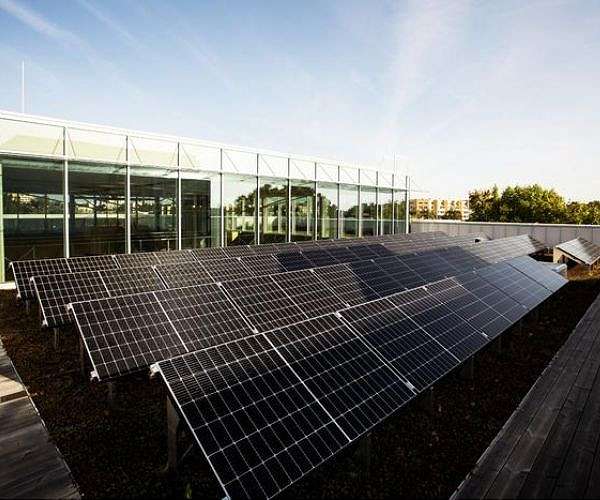
Lithuanian researchers advance solar cell technology
by Robert Schreiber
Berlin, Germany (SPX) May 16, 2024
Researchers from Kaunas University of Technology (KTU), Lithuania, who previously developed high-efficiency solar cells, have expanded their invention. The self-assembled monolayers can now be applied in both inverted and regular structure perovskite solar cells.
Self-assembling molecules form a single-molecule-thick layer, acting as an electron-transporting layer in solar cells.
“The molecules that make up these monolayers, like a clever glue, coat the surface of the constructed devices with a thin one molecule thick layer. And this is not random, they don’t stick wherever they go, but attach themselves by chemical bonds only where they are in contact with conductive metal oxide,” explained Tadas Malinauskas, Professor at KTU’s Faculty of Chemical Technology and one of the inventors of the new technology.
According to Malinauskas, creating such a layer is a simple and material-efficient process that requires a glass substrate with an electrically conductive metal oxide layer to be immersed in or sprayed with a highly diluted solution of the compound. The self-assembling molecules attach only to the metal oxide surface, with non-adhering molecules being washed away. This creates a thin layer precisely where it is needed.
KTU researchers have been synthesizing and studying charge-transporting organic materials for several years, focusing previously on molecules for positive charge transfer in perovskite solar cells.
“We can already say with confidence that these molecules have given a major boost to the development of the next generation solar cells. So, our next step is quite logical: to develop analogous molecules that can carry negative charges, and to apply these materials in perovskite solar cells,” said Vytautas Getautis, professor at the KTU Faculty of Chemical Technology and head of the research group.
Although it is a very thin layer, its role in solar cells is critical. Malinauskas compared its function to that of an automatic gate in the subway, allowing only one type of charge to pass through towards the electrode, thereby increasing solar cell efficiency.
Perovskite solar cell structures vary in layer sequence. In the regular structure, a negative charge transporting layer is formed on a transparent substrate, followed by light-absorbing and positive charge transporting layers. In the inverted structure, the positive and negative charge transport layers are swapped.
KTU PhD student Lauryna Monika Svirskaite explained that the main difference between the two structures lies in their application areas. The regular structure is used for studying low-cost, easier-manufactured but less efficient solar cells, while the inverted architecture allows for more efficient combined devices, known as tandem devices.
Currently, as both structures are being intensively researched, KTU scientists believe that their new invention is as significant and promising as their previous developments.
The new invention resulted from collaboration with scientists from King Abdullah University of Science and Technology (KAUST).
“We, KTU chemists, were responsible for the development, improvement, and optimisation of the materials and coating technology, while our colleagues from Saudi Arabia investigated the performance of it in solar cells,” revealed Malinauskas.
Greta Zekiene, head of Intellectual Property Management at KTU’s National Innovation and Entrepreneurship Centre (NIEC), said the demand for this invention is surprisingly high. Interest in the invention’s industrial use preceded the patent application filing.
“A Japanese company, with whom we already have several licences for inventions in this field, immediately expressed the interest to have the innovation in their product portfolio. They were waiting for us to prepare a patent application. The process of negotiating a licence agreement started right away,” said Zekiene.
She emphasized that obtaining a patent is not necessary for commercializing an invention, as it depends on the individual case. Commercialization can occur at any time if a business declares its intention to license or take over all the property rights.
Zekiene added that inventions in the field of solar cells made by the Synthesis of Organic Semiconductors research group are the strongest in KTU’s patent portfolio and receive significant interest from businesses. “We feel proud and acknowledged when companies want to start using the inventions as soon as possible,” she said.
Research Report:Nonfullerene Self-Assembled Monolayers As Electron-Selective Contacts for n-i-p Perovskite Solar Cells
Related Links
Kaunas University of Technology
All About Solar Energy at SolarDaily.com
- SEO Powered Content & PR Distribution. Get Amplified Today.
- PlatoData.Network Vertical Generative Ai. Empower Yourself. Access Here.
- PlatoAiStream. Web3 Intelligence. Knowledge Amplified. Access Here.
- PlatoESG. Carbon, CleanTech, Energy, Environment, Solar, Waste Management. Access Here.
- PlatoHealth. Biotech and Clinical Trials Intelligence. Access Here.
- Source: https://www.solardaily.com/reports/Lithuanian_researchers_advance_solar_cell_technology_999.html
